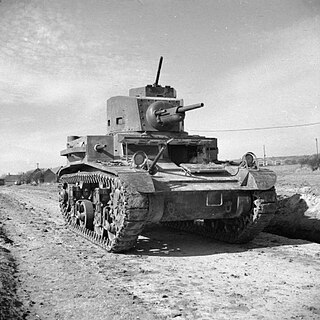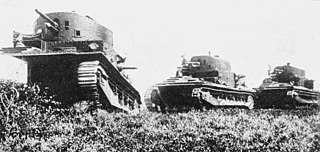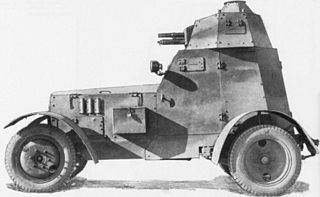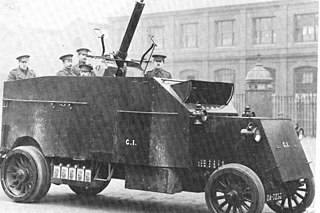
A military armoredcar is a wheeled armoured fighting vehicle, historically employed for reconnaissance, internal security, armed escort, and other subordinate battlefield tasks. With the gradual decline of mounted cavalry, armored cars were developed for carrying out duties formerly assigned to light cavalry. Following the invention of the tank, the armoured car remained popular due to its faster speed, comparatively simple maintenance and low production cost. It also found favor with several colonial armies as a cheaper weapon for use in underdeveloped regions. During World War II, most armoured cars were engineered for reconnaissance and passive observation, while others were devoted to communications tasks. Some equipped with heavier armament could even substitute for tracked combat vehicles in favorable conditions—such as pursuit or flanking maneuvers during the North African campaign.

The T-26 tank was a Soviet light tank used during many conflicts of the Interwar period and in World War II. It was a development of the British Vickers 6-Ton tank and was one of the most successful tank designs of the 1930s until its light armour became vulnerable to newer anti-tank guns. It was produced in greater numbers than any other tank of the period, with more than 11,000 units manufactured giving it the title of the most produced tank during the interwar period. During the 1930s, the USSR developed 53 variants of the T-26, including flame-throwing tanks, combat engineer vehicles, remotely controlled tanks, self-propelled guns, artillery tractors, and armoured carriers. Twenty-three of these were series-produced, others were experimental models.

AEC armoured cars are a series of British heavy armoured cars built by the Associated Equipment Company (AEC) during the Second World War.

The M2 light tank, officially Light Tank, M2, was an American light tank of the interwar period which saw limited service during World War II. The most common model, the M2A4, was equipped with one 37 mm (1.5 in) M5 gun and five .30 cal M1919 Browning machine guns.

The BRDM-1 is a Soviet amphibious armored scout car. It was the first purpose-built Soviet reconnaissance vehicle to enter service since the BA-64 and was built on the chassis and drive train of the BTR-40 armored personnel carrier. It is the world's first mass-produced combat vehicle of its class.

Tanks were initially deployed in World War I, engineered to overcome the deadlock of trench warfare. Between the two world wars, tanks were further developed. Although they had demonstrated their battlefield effectiveness, only a few nations had the industrial resources to design and build them. During and after World War I, Britain and France pioneered tank technology, with their models generally serving as a blueprint for other countries. However, this initial advantage would slowly diminish during the 1930s, shifting in favor of the Soviet Union and, to a lesser degree, Nazi Germany.

The Marmon–Herrington armoured car was a series of armoured vehicles that were produced in South Africa and adopted by the British Army during World War II. They were also issued to RAF armoured car companies, which seem never to have used them in action, making greater use of Rolls-Royce armoured cars and other types.

The Vickers Medium Mark I was a British tank of the Inter-war period built by Vickers from 1924.

The Austin armoured car was a British armoured car produced during the First World War. The vehicle is best known for its employment by the Imperial Russian Army in the First World War and by different forces in the Russian Civil War.

During the First World War, sixteen American Peerless trucks were modified by the British to serve as armoured cars. These were relatively primitive designs with open backs, armed with a Pom-pom gun and a machine gun, and were delivered to the British Army in 1915. They were used also by the Imperial Russian Army as self-propelled anti-aircraft guns.

Samochód pancerny wz. 34, was a standard light armored car used by the Polish Army during the September Campaign of 1939.

The Peugeot armoured car was a four-wheeled armoured vehicle based on a commercial Peugeot truck that was quickly developed by the French in 1914 for use during the First World War.
Smok Kaszubski was an improvised Polish armoured train, which served in the Polish defenses during the German invasion in 1939. The train was part of the Land Coastal Defence.

The Cypriot National Guard employs several armoured vehicles in its operations.

Throughout its history, the Irish Army has used a number of armoured fighting vehicles.

The Vickers T-15 light tank, full designation Char Léger de Reconnaissance Vickers-Carden-Loyd Mod.1934 T.15, was a light 4-ton tank of the Belgian Army. They were built by Vickers-Armstrong in the UK to the design of their Light Tank Mark III and outfitted with their armament in Belgium by Fonderie Royale de Canons (FRC) at Herstal. It entered service in 1935, and was used by the Belgian Army during the Battle of Belgium in May 1940. Its main armament was a 13.2 mm Hotchkiss machine gun. The tank was intended as a replacement for the venerable but obsolescent Renault FT. Only 42 were produced.

Samochód półgąsienicowy wz. 34 was a Polish halftrack lorry. It was produced in a variety of variants, the best-known of them being the C4P artillery tractor used by the Polish Army in the period before World War II.

The Seabrook armoured lorry was a British heavy armoured car built on the chassis of an American 5-ton truck which saw service with the Royal Naval Air Service during the First World War.

The White AM armoured car was a French First World War armoured car that was built on a commercial American White Motor Company truck chassis with armoured bodies supplied by the French firm Ségur & Lorfeuvre, it was used by the French military from its introduction in 1915. Between the wars the French military completely rebuilt the vehicles as the White-Laffly AMD 50 and the Laffly-Vincennes AMD 80, in these guises it served until at least 1943.

The Pierce-Arrow armoured AA lorry was a self-propelled anti-aircraft carrier mounting a QF 2-pounder AA "pom-pom" gun, it was used by the Royal Marine Artillery during the First World War.






















